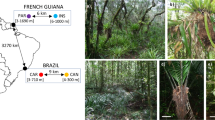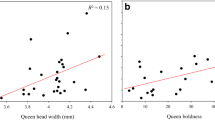Abstract
In most social insect species, individuals recognize and behave aggressively towards non-nestmate conspecifics to maintain colony integrity. However, introduced populations of the invasive Argentine ant, Linepithema humile, exhibit pronounced variation in intraspecific aggression denoting diversity in nestmate recognition behavior, which possibly shapes their social structure and the varying levels of unicoloniality observed among these populations. One approach to better understand differential aggression behaviors towards conspecifics and recognition cue perception and response in L. humile is to examine variation in nestmate discrimination capability among genetically distinct colonies under different social contexts. Consequently, we investigated the dynamics of queen and worker recognition in southeastern US L. humile queenless and queenright colonies by measuring rates of non-nestmate worker and queen adoption and intercolony genetic similarity. Aggression levels between colony pairs differed and were associated with non-nestmate worker, but not queen adoption. Adoption of queens and workers was a function of host colony origin, while colony queen number affected adoption of queens, but not workers, with queens more readily accepted by queenless hosts. Fecundity of adopted non-nestmate queens was comparable to that of rejected non-nestmate and host colony queens, suggesting that queen fecundity did not affect adoption decisions. Genetic similarity between colonies ranged from 30 to 77% alleles shared, with more genetically similar colonies showing lower levels of intraspecific aggression. Non-nestmate queens and workers that were more genetically similar to host colony workers were more likely to be adopted. We provide the first evidence for the role of L. humile colony queen number on queen discrimination and suggest an effect of resident queens on worker conspecific acceptance thresholds. Our findings indicate a role for genetically based cues in L. humile nestmate recognition. However, subtle discrimination capability seems to be influenced by the social context, as demonstrated by more frequent recognition errors in queenless colonies.



Similar content being viewed by others
References
Balas MT (2005) Conditions favoring queen execution in young social insect colonies. Insectes Soc 52:77–83
Beye M, Neumann P, Moritz RFA (1997) Nestmate recognition and the genetic gestalt in the mound-building ant Formica polytecna. Insectes Soc 44:49–58
Bhatkar AD, Whitcomb WH (1970) Artificial diet for rearing various species of ants. Florida Entomol 53:229–232
Bourke AFG, Franks NR (1995) Social evolution in ants. Princeton University Press, Princeton, New Jersey
Breed MD, Bennett B (1987) Kin recognition in highly eusocial insects. In: Fletcher DJC, Michener CD (eds) Kin recognition in animals. Wiley, New York, pp 243–285
Brian MV (1986) Bonding between workers and queens in the ant genus Myrmica. Anim Behav 34:1135–1145
Buczkowski G, Silverman J (2005) Context-dependent nestmate discrimination and the effect of action thresholds on exogenous cue recognition in the Argentine ant. Anim Behav 69:741–749
Buczkowski G, Silverman J (2006) Geographical variation in Argentine ant aggression behaviour mediated by environmentally derived nestmate recognition cues. Anim Behav 71:327–335
Buczkowski G, Vargo EL, Silverman J (2004) The diminutive supercolony: the Argentine ants of the southeastern United States. Mol Ecol 13:2235–2242
Carlin NF, Hölldobler B (1986) The kin recognition system of carpenter ants (Camponotus spp.) I. Hierarchical cues in small colonies. Behav Ecol Sociobiol 19:123–134
Chen YP, Vinson SB (2000) Effects of queen attractiveness to workers on the queen nutritional status and egg production in the polygynous Solenopsis invicta (Hymenoptera: Formicidae). Ann Entomol Soc Amer 93:295–302
Crosland MWJ (1990) The influence of the queen, colony size and worker ovarian development on nestmate recognition in the ant Rhytidoponera confusa. Anim Behav 39:413–425
Crozier RH, Pamilo P (1996) Evolution of social insect colonies. Oxford University Press, Oxford
De Biseau JC, Passera L, Daloze D, Aron S (2004) Ovarian activity correlates with extreme changes in cuticular hydrocarbon profile in the highly polygynous ant, Linepithema humile. J Insect Physiol 50:585–593
Downs SG, Ratnieks FLW (2000) Adaptive shifts in honey bee (Apis mellifera L.) guarding behavior support predictions of acceptance threshold model. Behav Ecol 11:326–333
Errard C, Jallon JM (1987) An investigation of the development of the chemical factors in ants intra-society recognition. In: Eder J, Rembold H (eds) Chemistry and biology of social insects. Verlag J. Peperny, Munich, p 478
Errard C, Hefetz A, Jaisson P (2006) Social discrimination tuning in ants: template formation and chemical similarity. Behav Ecol Sociobiol 59:353–363
Fletcher DJC, Blum MS (1983) Regulation of queen number by workers in colonies of social insects. Science 219:312–314
Fletcher DJC, Michener CD (1987) Kin recognition in animals. Wiley, New York
Fortelius W, Rosengren R, Cherix D, Chautems D (1993) Queen recruitment in a highly polygynous supercolony of Formica lugubris (Hymenoptera: Formicidae). Oikos 67:193–200
Fournier D, Keller L (2001) Partitioning of reproduction among queens in the Argentine ant, Linepithema humile. Anim Behav 62:1039–1045
Gamboa G (2004) Kin recognition in eusocial wasps. Ann Zool Fenn 41:789–808
Gamboa G, Reeve HK, Pfennig D (1986) The evolution and ontogeny of nestmate recognition in social wasps. Annu Rev Entomol 31:431–454
Giraud T, Pedersen JS, Keller L (2002) Evolution of supercolonies: the Argentine ants of southern Europe. Proc Natl Acad Sci USA 99:6075–6079
Goudet J (1995) FSTAT (version 1.2): a computer program to calculate F-statistics. J Heredity 86:485–486
Hamilton WD (1964) The genetical evolution of social behaviour, I and II. J Theor Biol 7:1–52
Herbers JM (1993) Ecological determinants of queen number in ants. In: Keller L (ed) Queen number and sociality in insects. Oxford University Press, Oxford, pp 262–293
Hölldobler B, Michener CD (1980) Mechanisms of identification and discrimination in social Hymenoptera. In: Markl H (ed) Evolution of social behaviour: hypotheses and empirical tests. Verlag Chemie GmbH, Weinheim, pp 35–57
Hölldobler B, Wilson EO (1990) The ants. The Belknap Press of Harvard University Press, Cambridge, Massachusetts
Ingram KK (2002) Plasticity in queen number and social structure in the invasive Argentine ant (Linepithema humile). Evolution 56:2008–2016
Keller L (1988) Evolutionary implications of polygyny in the Argentine ant, Iridomyrmex humilis (Mayr), (Hymenoptera: Formicidae): an experimental study. Anim Behav 35:159–165
Keller L, Nonacs P (1993) The role of queen pheromones in social insects: queen control or queen signal? Anim Behav 45:787–794
Keller L, Ross GR (1993) Phenotypic basis of reproductive success in a social insect: genetic and social determinants. Science 260:1107–1110
Keller L, Vargo EL (1993) Reproductive structure and reproductive roles in colonies of eusocial insects. In: Keller L (ed) Queen number and sociality in insects. Oxford University Press, Oxford, pp 16–44
Keller L, Passera L, Suzzoni J (1989) Queen execution in the Argentine ant, Iridomyrmex humilis. Physiol Entomol 14:157–163
Krieger MJB, Keller L (1999) Low polymorphism at 19 microsatellite loci in a French population of Argentine ants (Linepithema humile). Mol Ecol 8:1075–1092
Krieger MJB, Ross KG (2002) Identification of a major gene regulating complex social behaviour. Science 295:328–332
Lacy RC, Sherman PW (1983) Kin recognition by phenotype matching. Am Nat 121:489–512
Liang D, Silverman J (2000) ‘You are what you eat’: diet modifies cuticular hydrocarbons and nestmate recognition in the Argentine ant, Linepithema humile. Naturwissenschaften 87:412–416
Liebert AE, Starks PT (2004) The action component of recognition systems: a focus on the response. Ann Zool Fenn 41:747–764
Mantel N (1967) The detection of disease clustering and a generalized regression approach. Cancer Res 27:209–220
Markin GP (1970) The seasonal life cycle of the Argentine ant, Iridomyrmex humilis (Hymenoptera: Formicidae), in Southern California. Ann Entomol Soc Am 63:1238–1242
Morel L, Vander Meer RK, Lofgren CS (1990) Comparison of nestmate recognition between monogyne and polygyne populations of Solenopsis invicta (Hymenoptera: Formicidae). Ann Entomol Soc Am 83:642–647
Newell W, Barber TC (1913) The Argentine ant. USDA Bureau of Entomology 122:1–98
Obin MS, Vander Meer RK (1989) Nestmate recognition in fire ants (Solenopsis invicta Buren) Do queens label workers? Ethology 80:255–264
Passera L, Aron S, Bach D (1995) Elimination of sexual brood in the Argentine ant Linepithema humile: queen effect and brood recognition. Entomol Exp et Appl 75:203–212
Pedersen JS, Krieger MJB, Vogel V, Giraud T, Keller L (2006) Native supercolonies of unrelated individuals in the invasive Argentine ant. Evolution 60:782–791
Pirk CWW, Neumann P, Moritz RFA, Pamilo P (2001) Intranest relatedness and nestmate recognition in the meadow ant Formica pratensis (R.). Behav Ecol Sociobiol 49:366–374
Provost E (1989) Social environment factors influencing mutual recognition of individuals in the ant Leptothorax lichtensteini Bondr. (Hymenoptera: Formicidae). Behav Processes 18:35–59
Provost E (1991) Nonnestmate kin recognition in the ant Leptothorax lichtensteini: evidence that genetic factors regulate colony recognition. Behav Genet 21:151–167
Provost E, Cerdan P, Bagneres AG, Morgan D, Riviere G (1992) Role of the queen in Messor barbarus colony signature. In: Billen J (ed) Biology and evolution of social insects. Leuven University Press, Leuven, Belgium, pp 195–202
Provost E, Riviere G, Roux M, Bagneres AG, Clement JL (1994) Cuticular hydrocarbons whereby Messor barbarus ant workers putatively discriminate between monogynous and polygynous colonies. Are workers labeled by queens? J Chem Ecol 20:2985–3003
Reeve HK (1989) The evolution of conspecific acceptance thresholds. Am Nat 133:407–435
Reeve HK, Ratnieks FL (1993) Queen-queen conflicts in polygynous societies: mutual tolerance and reproductive skews. In: Keller L (ed) Queen number and sociality in insects. Oxford University Press, Oxford, pp 45–85
Reuter M, Balloux F, Lehmann L, Keller L (2001) Kin structure and queen execution in the Argentine ant Linepithema humile. J Evol Biol 14:954–958
Roulston TH, Buczkowski G, Silverman J (2003) Nestmate discrimination in ants: effect of bioassay on aggressive behavior. Insectes Soc 50:151–159
SAS Institute (2000) SAS online document, version 8.2. SAS Institute, Cary, North Carolina
Starks PT (2003) Selection for uniformity: xenophobia and invasion success. Trends Ecol Evol 18:159–162
Starks PT, Watson RE, Dipaola J, Dipaola CP (1998) The effect of queen number on nestmate discrimination in the facultatively polygynous ant Pseudomyrmex pallidus (Hymenoptera: Formicidae). Ethology 104:573–584
Stuart RJ (1988) Collective cues as a basis for nestmate recognition in polygynous lepthothoracine ants. Proc Natl Acad Sci USA 85:4572–4575
Stuart RJ, Greshambissett L, Alloway TM (1993) Queen adoption in the polygynous and polydomous ant, Leptothorax curvispinosus. Behav Ecol 4:276–281
Suarez AV, Holway DA, Liang DS, Tsutsui ND, Case TJ (2002) Spatio-temporal patterns of intraspecific aggression in the invasive Argentine ant. Anim Behav 64:697–708
Sudd JH, Franks NR (1987) The behavioural ecology of ants. Chapman and Hall, New York
Sundström L (1997) Queen acceptance and nestmate recognition in monogyne and polygyne colonies of the ant Formica truncorum. Anim Behav 53:499–510
Tsutsui ND, Case TJ (2001) Population genetics and colony structure of the Argentine ant (Linepithema humile) in its native and introduced range. Evolution 55:976–985
Tsutsui ND, Suarez AV, Holway DA, Case TJ (2000) Reduced genetic variation and the success of an invasive species. Proc Natl Acad Sci USA 97:5948–5953
Tsutsui ND, Suarez AV, Grosberg RK (2003) Genetic diversity, asymmetrical aggression, and recognition in a widespread invasive species. Proc Natl Acad Sci USA 100:1078–1083
Vander Meer RK, Alonso LE (2002) Queen primer pheromone affects conspecific fire ant (Solenopsis invicta) aggression. Behav Ecol Sociobiol 51:122–130
Vander Meer RK, Morel L (1998) Nestmate recognition in ants. In: Vander Meer RK, Breed M, Winston M, Espelie KE (eds) Pheromone communication in social insects. Westview Press, Boulder, Colorado, pp 79–103
Vargo EL, Passera L (1991) Pheromonal and behavioral queen control over the production of gynes in the Argentine ant Iridomyrmex humilis (Mayr). Behav Ecol Sociobiol 28:161–169
Vargo EL, Ross KG (1989) Differential viability of eggs laid by queens in polygyne colonies of the fire ant, Solenopsis invicta. J Insect Physiol 35:587–593
Acknowledgements
We thank C. Schal, E. Vargo, W. Watson, and three anonymous reviewers for helpful comments on the manuscript. We also thank C. Brownie for statistical advice and A. Carper, J. Leonard, and P. Labadie for technical assistance. This study was supported by the Blanton J. Whitmire Endowment at North Carolina State University and the David R. Nimocks fellowship (G. V.).
Author information
Authors and Affiliations
Corresponding author
Additional information
Communicated by L. Sundström
Rights and permissions
About this article
Cite this article
Vásquez, G.M., Silverman, J. Queen acceptance and the complexity of nestmate discrimination in the Argentine ant. Behav Ecol Sociobiol 62, 537–548 (2008). https://doi.org/10.1007/s00265-007-0478-z
Received:
Revised:
Accepted:
Published:
Issue Date:
DOI: https://doi.org/10.1007/s00265-007-0478-z




